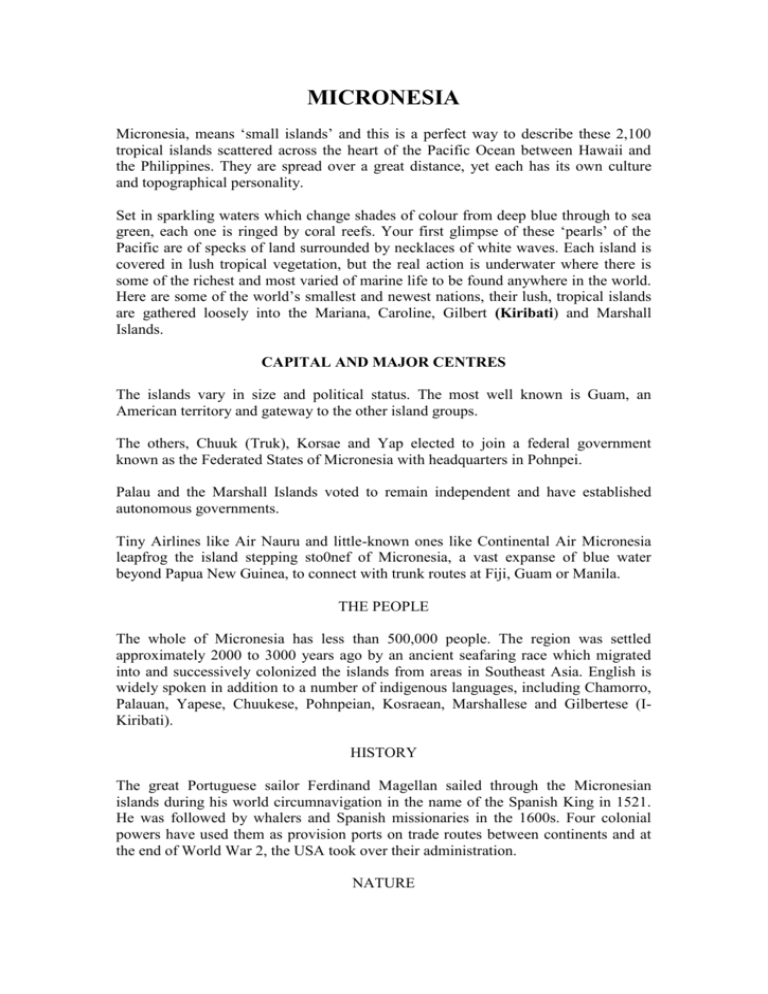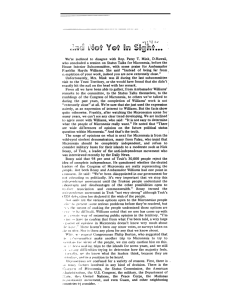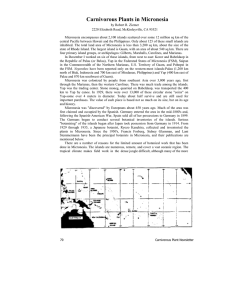capital and major centres
advertisement

MICRONESIA Micronesia, means ‘small islands’ and this is a perfect way to describe these 2,100 tropical islands scattered across the heart of the Pacific Ocean between Hawaii and the Philippines. They are spread over a great distance, yet each has its own culture and topographical personality. Set in sparkling waters which change shades of colour from deep blue through to sea green, each one is ringed by coral reefs. Your first glimpse of these ‘pearls’ of the Pacific are of specks of land surrounded by necklaces of white waves. Each island is covered in lush tropical vegetation, but the real action is underwater where there is some of the richest and most varied of marine life to be found anywhere in the world. Here are some of the world’s smallest and newest nations, their lush, tropical islands are gathered loosely into the Mariana, Caroline, Gilbert (Kiribati) and Marshall Islands. CAPITAL AND MAJOR CENTRES The islands vary in size and political status. The most well known is Guam, an American territory and gateway to the other island groups. The others, Chuuk (Truk), Korsae and Yap elected to join a federal government known as the Federated States of Micronesia with headquarters in Pohnpei. Palau and the Marshall Islands voted to remain independent and have established autonomous governments. Tiny Airlines like Air Nauru and little-known ones like Continental Air Micronesia leapfrog the island stepping sto0nef of Micronesia, a vast expanse of blue water beyond Papua New Guinea, to connect with trunk routes at Fiji, Guam or Manila. THE PEOPLE The whole of Micronesia has less than 500,000 people. The region was settled approximately 2000 to 3000 years ago by an ancient seafaring race which migrated into and successively colonized the islands from areas in Southeast Asia. English is widely spoken in addition to a number of indigenous languages, including Chamorro, Palauan, Yapese, Chuukese, Pohnpeian, Kosraean, Marshallese and Gilbertese (IKiribati). HISTORY The great Portuguese sailor Ferdinand Magellan sailed through the Micronesian islands during his world circumnavigation in the name of the Spanish King in 1521. He was followed by whalers and Spanish missionaries in the 1600s. Four colonial powers have used them as provision ports on trade routes between continents and at the end of World War 2, the USA took over their administration. NATURE The islands of Micronesia are naturally diverse and include high volcanic islands such as Pohnpei and Korsae, raised coral islands such as Guam and Saipan, and coral atolls such as the Marshall and Gilbert (Kiribati) Islands. The inhabited parts vary from villages with no cars or electricity to the sophisticated resort areas of Guam and Saipan. The underwater wildlife is particularly diverse; Micronesia offers some of the most pristine and biodiverse underwater environments, which make scuba diving here excellent. Birds and plants abound on all of Micronesia’s islands. THE SIGHTS Geologically, culturally and naturally diverse, the islands of Micronesia offer a wide array of natural and man-made attractions. These range from pristine underwater environments and lush island landscapes to sprawling resort areas with shopping and nightlife. See individual sections for more details. WHERE TO STAY Each island differs in accommodation from native style thatch cottages to hotels and resorts. The more developed islands such as Guam, Saipan and Palau have international hotels. Rota also has several new hotels and a resort with an 18-hole golf course. In the Marshall Islands guest accommodation on some of the outer islands is in traditional thatched huts with few amenities. GETTING AROUND All the islands have limited transport in the form of taxis, buses and rental cars. Most resorts and hotels offer mini-bus shuttle services to airports and other areas. FOOD AND ENTERTAINMENT The islands which are best equipped for tourism offer world-class seafood restaurants. In Guam, Palau and Saipan you can sample a variety of cuisine including American, Japanese, Korean, Chinese, Philippine, Mexican and Chamorro cooking. In the Marshall Islands, American, Western style cooking and Chinese cuisine goes hand-inhand with Marshallese specialties. ACTIVITIES There is a diverge range of water based activities including snorkelling, kayaking, diving and swimming in the exquisite clear blue water which offers colourful corals and lots of sunken historical objects. SHOPPING Jade, coral, ivory, gold and handmade silks are available plus handicrafts such as trays, baskets, hats, headbands and purses. The islanders are known fo their weaving of pandanus leaves and for their traditional stick charts which have been used for centuries by the fishermen for navigation. FACTS AT A GLANCE Climate Tropical with little seasonal change. Average temperature on all the islands is 30C. Clothing Casual clothing, although swimwear is not normally permitted in the public areas of hotels. Electricity Standard 110 volt. Time Zone Guam, Yap, Saipan and Chuuk are on the same time zone as east coast Australia. (GMT plus 10 hours). Pohnpei is one hour ahead of east coast Australia and the Marshall Islands are 2 hours ahead. Palau is one hour behind east coast of Australia. Currency US currency is used throughout Micronesia. Outside of Guam and Saipan, the use of credit cards is very limited, although major hotels on all islands take them. Tipping Tips are accepted. Visas and Health Non US citizens must hold a valid passport and onward airline ticket. Australian passport holders do not require a US visa to visit any of the islands, but must complete a Visa Waiver Form. Always confirm current entry requirements with your travel agent. Getting There Continental Airlines, Japan Airlines, Northwest Airlines, All Nippon Airways, Pacific Missionary Aviation, Marshall Islands Airways, Aloha Airlines, and Air Nauru. All islands are serviced on a regular basis by Continental Micronesia or ‘Air Mike’ as they are known locally.








